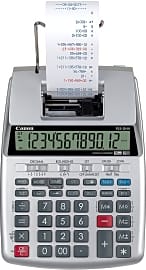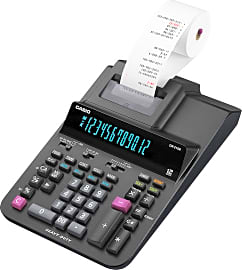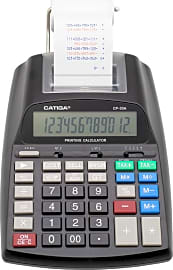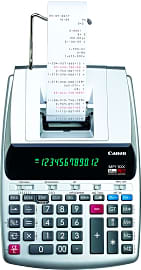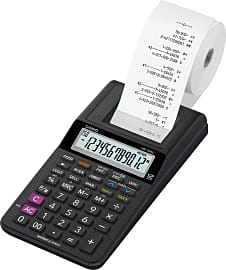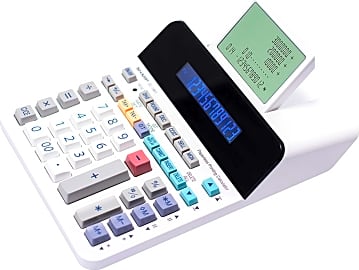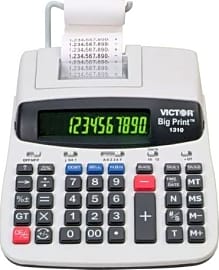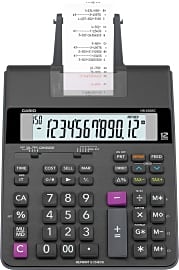The 10 Best Printing Calculators

This wiki has been updated 40 times since it was first published in May of 2016. Whether you're running your own business, keeping track of your budgeting, or braving tax season, a reliable calculator is a necessity. One of the printable models on our list will allow you to easily crunch numbers and generate receipts. Available in both portable and desktop models that run on batteries and/or AC power, these calculators are perfect for a variety of applications. When users buy our independently chosen editorial selections, we may earn commissions to help fund the Wiki.
Editor's Notes
December 08, 2020:
If you frequently travel to different job sites or take your work home each evening, you may want something compact and portable that you can toss in a bag fairly easily. The lightest options on our list are the Casio HR-100TM and the Casio HR-10RC, each of which weighs just one pound. The latter is the smaller of the two, at eight by four inches, however, it also has one of the slowest printing speeds, generating just one line per 1.6 seconds, along with the Catiga Commercial, which has a similar speed. Because of this, these models wouldn’t work for an experienced person, but may be just right for casual use.
On that note, if you are an experienced typists and need something that will keep up, we have included a couple suitable options. The Sharp EL-1197 features a medium printing speed of 4.3 lines per second. It also has a superior four-key independent memory. However, it’s worth noting that it’s the largest and heaviest of those on our list, so if portability is a necessity, it may not work for you. Our fastest-printing model is the heavy-duty Victor 1310, which prints at a rate of six lines per second. If you work fast, this is a smart choice for you. It also uses high-quality thermal paper, which makes for a super quiet print experience. Although it is more expensive than regular paper, the extra cost may be preferable to disturbing the entire household.
Several of our listed calculators include special features that may make your life easier, depending on your needs. For example, if you want to collect more than one copy of each input, look for an option with a desirable “reprint” feature, like the Casio HR-200RC and the previously mentioned Casio HR-10RC. These models allow you to print multiple copies of the same transaction, saving you from the tedious task of reentering information. Alternatively, if you're embracing the digital age and don't care about having a tangible print-out, you may like the Sharp EL-1901. It's a paperless calculator that saves hundreds of entries, which are accessible via the easy-to-read display screen.
May 13, 2019:
Because it's currently tough to find the Casio FR-2650TM, we decided to remove it, but we still think that the Monroe UltimateX, Sharp EL-1197, and Victor 1460-4 are all fine choices. The UltimateX is a strong option for professional use, with all the features accountants and payroll managers could desire, but it does have the outsized price tag to match. The latter two are not as expensive but still relatively feature-heavy, both printing at a speed of around four lines per second to save you some time. As for more budget-friendly models, we decided to add the Casio HR-100TM. Although it's quite similar to the Casio HR-170RC, it tends to be less expensive and has slightly fewer features, which makes it a good option for non-professionals who don't need all the bells and whistles. Finally, after deliberation, we have elected to add the Sharp EL-1901. It does not actually print onto paper; instead, it features a screen that displays information so you can visually keep track of your calculations. This will save you from having to buy ink and supplies, but you also won't have a physical record, which may or may not be a deal breaker.
The Evolution Of Calculation Innovation
Others believe that the notches' groupings are extremely significant, and indicate that these were actually very early calculators.
Math has been around for just about as long as sentient humans. At its heart, the science relies on numbers, and those numbers can be real, like measurements of dimensions and angles, or theoretical, such as complex variables. The interactions between these numbers lead to conventions as straightforward as planning a bed of crops, or as advanced as parsing Einstein's relativity.
Human beings are incredibly smart — we wouldn't have made it this far if that wasn't the case. But while our brains excel at creative problem solving, they're usually not so well-suited to high-level computation. For as long as humans have counted, we've used tools to enhance our calculation skills. Today there are many different electronic devices that help us do math, but like any technology, the calculator comes from quite humble roots.
In the mid-20th century, archaeologists unearthed a few bones from ancient sites that were dated at about 20,000 and 40,000 years old. Called the Ishango and Lebombo bones, respectively, they each sported a unique set of notches, arranged in columns and groups along the side of the piece. At first glance, they appeared to be simple tally sticks, prehistoric record-keeping devices, and to this day some researchers insist that's all they are. Others believe that the notches' groupings are extremely significant, and indicate that these were actually very early calculators. If accurate, this would mean that the first relatively advanced mathematicians lived sometime around the year 40000 B.C.E. or earlier — or about one-fifth of the time since homo sapiens actually evolved.
There's evidence of geometric calculations and designs from several thousand years ago, and many scientists believe that heritage sites such as Stonehenge, as well as certain burial grounds and petroglyphs, utilize circular mechanics that indicate a rudimentary understanding of geometry. Beginning around the year 2000 B.C.E., the abacus saw widespread use, starting in Egypt and spreading outward. It was the next major evolution of the device that would ultimately become the modern calculator. The early 1600s C.E. saw the development of important milestones, like Galileo's proportional compass, as well as Napier's calculating bones, the latter of which was developed by the genius responsible for introducing logarithmic theory to the mathematical world. Over the next 300 years, incremental versions of mechanical calculators came and went, but it wasn't until the industrial revolution that they gained popularity. The development of vacuum tubes and transistors paved the way for several decades of rapid advancement, eventually leading to the modern calculator.
What's The Point Of A Printer?
The 1950s and 1960s weren't known for lightweight, portable electronic devices, and calculators of that time followed in this tradition. Nonetheless, as soon as these bulky, desktop machines were available, they saw immediate military, business, and finance applications. Cathode-ray tubes and filament lamps evolved into LCD screens, and printed displays advanced in a number of forms. While mechanical printing calculators first came about in the late 1800s, electronic versions proved the perfect, lasting companion to the burgeoning field of accounting during the massive, worldwide economic expansion of the 20th century.
Even though integrated digital displays are standard on almost every calculator, printing varieties still offer the benefit of a permanent record, a must for any professional bookkeeper. A simple, one-line device relies on the user's perfect accuracy and decent memory to make multi-step calculations. However, with a printer, a glance at the last few lines is all it takes to recall particular payment amounts or find input errors. Furthermore, a financier can tear away the paper strip of calculations and store it alongside a client's file, a bundle of receipts, or a stack of credit card slips. This makes it easy for one or more workers to check their footing (and even cross-check their cross-footing), which goes a long way toward preventing potentially time-consuming and expensive mistakes.
Why They're So Special
Also called adding machines, these devices differ from standard calculators in a few important ways, aside from merely the printer. Though they perform considerably fewer functions than today's advanced scientific and graphing calculators, they do usually have a set of memory controls, as well as a variety of finance-related operations. Unlike most pocket calculators, which are small and lightweight, these are generally somewhat large, hefty, and very stable, usually with sturdy, non-slip feet. Their desktop design, coupled with traditionally ultra-responsive keys, allow skilled number-crunchers to input numbers at a high speed with few errors. Also, adding machines most often have buttons dedicated to controlling the printing mechanism, as well as built-in date and timestamps. And because they're designed for financial purposes rather than scientific or educational means, their displays always refer to values of currency. In fact, many of them feature built-in equations that keep you from making any errors during the tedious currency-conversion process.
In fact, many of them feature built-in equations that keep you from making any errors during the tedious currency-conversion process.
The printers themselves use one of three primary methods. Many use a simple ink-roller system, while others use a system called thermal transfer that involves a roll of pigmented, heat-sensitive ribbon and special paper. Both of these come in 1- and 2-color varieties, with black and red typeface often representing positive and negative inputs, respectively. Another model mimics the typical point-of-sale receipt printer by simply applying direct heat to thermal paper. This type is considered easier to maintain, as it doesn't have ribbons or ink to replace, though the paper is prone to smudges and distortion, and may not hold up as well over time.
Savvy investors, small business owners, and corporate auditors are all likely to need a quality, reliable adding machine, as will as anyone knee-deep in taxes. They're not terribly expensive, and the value of accurate, easily verified bookkeeping is hard to overstate. Their long-serving design and generally robust construction ensure that the right choice will prove to be a very worthwhile investment.



